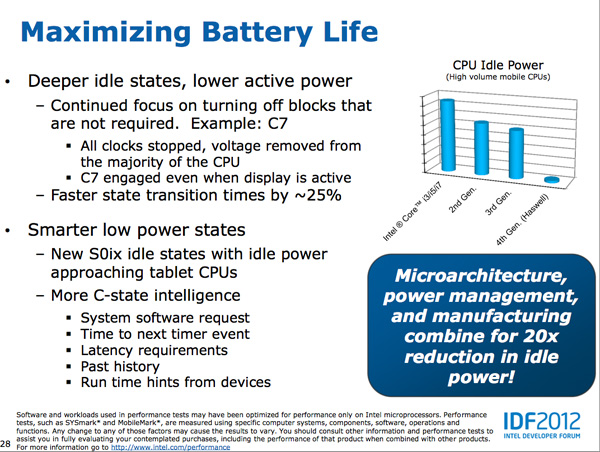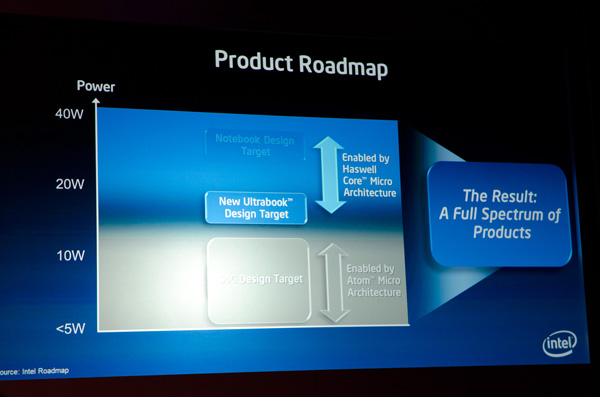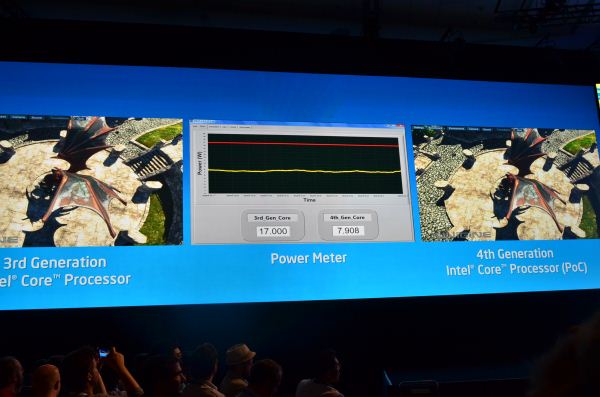Intel's Haswell Architecture Analyzed: Building a New PC and a New Intel
by Anand Lal Shimpi on October 5, 2012 2:45 AM ESTOther Power Savings
Haswell's power savings come from three sources, all of which are equally important. We already went over the most unique: Intel's focus on reducing total platform power consumption by paying attention to everything else on the motherboard (third party controllers, voltage regulation, etc...). The other two sources of power savings are more traditional, but still very significant.

At the micro-architecture level Intel added more power gating and low power modes to Haswell. The additional power gating gives the power control unit (PCU) more fine grained control over shutting off parts of the core that aren't used. Intel published a relatively meaningless graph showing idle power for standard voltage mobile Haswell compared to the previous three generations of Core processors.
Haswell can also transition between power states approximately 25% faster than Ivy Bridge, which lets the PCU be a bit more aggressive in which power state it selects since the penalty of coming out of it is appreciably lower. It's important to put the timing of all of this in perspective. Putting the CPU cores to sleep and removing voltage/power from them even for a matter of milliseconds adds up to the sort of savings necessary to really enable the sort of always-on, always-connected behavior Haswell based systems are expected to deliver.
Intel has also done a lot of work at the process level to bring Haswell's power consumption down. As a tock, Haswell is the second micro-architecture to use Intel's new 22nm tri-gate transistors. The learnings from Ivy Bridge are thus all poured into Haswell. Intel wasn't too specific on what it did on the manufacturing side to help drive power down in Haswell other than to say that a non-insignificant amount of work came from the fabs.
The Fourth Haswell
At Computex Intel's Mooly Eden showed off this slide that positioned Haswell as a 15-20W part, while Atom based SoCs would scale up to 10W and perhaps beyond:
Just before this year's IDF Intel claimed that Haswell ULT would start at 10W, down from 17W in Sandy/Ivy Bridge. Finally, at IDF Intel showed a demo of Haswell running the Unigen Heaven benchmark at under 8W:
The chain of events tells us two things: 1) Intel likes to play its cards close to its chest, and 2) the sub-10W space won't be serviced by Atom exclusively.
Intel said Haswell can scale below 10W, but it didn't provide a lower bound. It's too much to assume Haswell would go into a phone, but once you get to the 8W point and look south you open yourself up to fitting into things the size of a third generation iPad. Move to 14nm, 10nm and beyond then it becomes more feasible that you could fit this class of architecture into something even more portable.
Intel is being very tight lipped about the fourth client Haswell (remember the first three were desktop, mobile and ultra-low-volt/Ultrabook) but it's clear that it has real aspirations to use it in a space traditionally reserved for ARM or Atom SoCs.
One of the first things I ever heard about Haswell was that it was Intel's solution to the ARM problem. I don't believe a 10W notebook is going to do anything to the ARM problem, but a sub-8W Haswell in an iPad 3 form factor could be very compelling. Haswell won't be fanless, but Broadwell (14nm) could be. And that could be a real solution to the ARM problem, at least outside of a phone.
As I said before, I don't see Haswell making it into a phone but that's not to say a future derivative on a lower power process wouldn't.













245 Comments
View All Comments
jigglywiggly - Friday, October 5, 2012 - link
wish the onboard gpu was better =/woula been nice for a laptop
tipoo - Friday, October 5, 2012 - link
2x the HD4000 is pretty decent for integrated. I wonder if that's 2x with or without the eDRAM cache though.ElvenLemming - Friday, October 5, 2012 - link
It's been known for a while that Haswell was only going to have a moderate improvement in the iGPU and the next big overhaul would be coming with Broadwell.csroc - Friday, October 5, 2012 - link
This is impressive, it might convince me it's time for a new laptop. On the other hand I also need to build a new desktop workstation and Haswell so far hasn't impressed me in that space.mayankleoboy1 - Friday, October 5, 2012 - link
Is Intel sacrificing Desktop CPU performance to make an architecture that is geared to the mobile space ?csroc - Friday, October 5, 2012 - link
It feels that way to me. Mobile performance seems to be their big concern now, that and improving the GPU. Two things I generally can't be bothered to care about when I'm looking to build a new workstation. I suspect I'll build an Ivy Bridge system because I could use it now and see nothing worth getting excited about.dishayu - Friday, October 5, 2012 - link
I fully share your sentiment. TO be very crude, i don't mind at all, paying for power imporvements, because it will pay back for itself in the long term (by consuming less power AND needing lesser cooling). But i DO mind very much, paying for 40 EUs of GPU on my desktop build which i will not use even for a second. Me, you and many others do not care about on-die graphics and Intel should realize that.I don't know why intel can't offer us both GPU and GPU-less options, the way they did with motherboards back in the days? P965 had no graphics, G965 did. Pretty sure it's technologically not an issue.
DanNeely - Friday, October 5, 2012 - link
If it makes you feel any better; reports elsewhere are that GT3 will be mobile only, because desktops don't have the power/size constraints driving the need for premium IGPs.Intel's not IGP CPUs are the E series parts; unfortunately they've failed to execute on the enthusiast side in terms of price/launch date leaving them as mostly server parts.
There just aren't enough of us to justify Intel adding another die design for their mass market socket that doesn't have an IGP at all instead of just letting us turn it off and use the extra TDP headroom for more time at boost speeds.
Omoronovo - Friday, October 5, 2012 - link
I'm somewhat in disagreement with you both.Whilst I share a concern that Intel is no longer focusing on raw performance improvements in the purely desktop space, they are still delivering incremental updates to the architecture that will benefit all current software (even if only marginally). However, processor performance has been reaching more and more diminishing returns in recent years, namely that software is simply not able to take advantage of multiple cores and improved performance because of (primarily) locks and complexity in creating multi-threaded applications.
As such, Intel has been focusing on that area - to make it easier for software and software developers to take advantage of the performance that exists *now* rather than brute forcing the issue by simply delivering more raw performance (much of which will be wasted/remain idle due to current software constraints).
With this, Intel has been able to focus on keeping performance high whilst subsequently dropping power usage substantially - the fact the iGPU is oftentimes not being used in a desktop environment does not invalidate it's utility - QuickSync is a prime example of where the gpu can accelerate certain types of processing, and if more software takes advantage of this we should see even more gains in future.
For the last 6 years or so, Intel has shown that it knows what demands will be placed on future computing hardware, and they seem convinced that this is the way to go. We might not be there yet, but technologies like C++AMP, OpenCL and such make me hopeful that this will change in a few years.
cmrx64 - Friday, October 5, 2012 - link
I solved this problem by buying an Ivy Bridge Xeon (specifically, an E3-1230v2). No GPU, lower power consumption than the equivalent i5/i7, has hyperthreading, performs really good, and a lot cheaper than an i7.If you don't care about the GPU, look to the Xeon line.